
The leopard tortoise is a large and attractively marked tortoise found in the savannas of eastern and southern Africa, from Sudan to the southern Cape Province. It is the only extant member of the genus Stigmochelys, although in the past, it was commonly placed in Geochelone. This tortoise is a grazing species that favors semiarid, thorny to grassland habitats. In both very hot and very cold weather, it may dwell in abandoned fox, jackal, or aardvark burrows. The leopard tortoise does not dig other than to make nests in which to lay eggs. Given its propensity for grassland habitats, it grazes extensively upon mixed grasses. It also favors succulents and thistles.

Forsten's tortoise, also known commonly as the Sulawesi tortoise, is a species of tortoise in the family Testudinidae. The species is native to Sulawesi Island, Indonesia.

Kleinmann's tortoise, also called commonly the Egyptian tortoise, Leith's tortoise, and the Negev tortoise, is a critically endangered species of cryptodire turtle in the family Testudinidae. The species is native to Egypt, Libya, and Israel/ Palestine. The species was once more widespread, but its numbers are now dwindling. The species is nearly extinct in Egypt, and complete extinction in the wild is a looming threat unless more actions are taken to protect this species.

Villa's gray shrew is a shrew native to northeastern Mexico, where it is called musaraña.
The Ecuadorian horned frog is a species of frog in the family Ceratophryidae. It is endemic to Ecuador. Its natural habitats are subtropical or tropical moist montane forest and intermittent freshwater marshes.
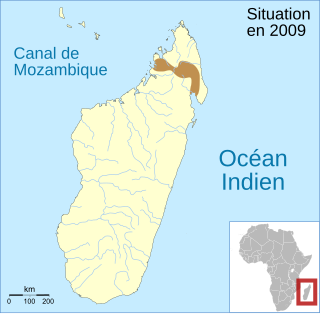
Rhombophryne minuta is a species of frog in the family Microhylidae. It is endemic to northern Madagascar. It has been mixed with other species such as Rhombophryne mangabensis; it is known with certainty only from the Marojejy National Park.

Rhombophryne is a genus of microhylid frogs endemic to Madagascar. It is currently estimated to include more than 23 species, but only 20 of these are currently described. The common name 'diamond frog' has been proposed and used for members of this genus.

Anilany helenae is a species of frog in the microyhlid subfamily Cophylinae. It is the only species in the monotypic genus Anilany, and is endemic to central Madagascar.

Hombron's kingfisher or the blue-capped kingfisher is a species of bird in the family Alcedinidae endemic to the Philippines and found only on Mindanao. It is one of the most colorful kingfishers in the country having a dark blue cap and wings with rufous spots, a striped rufous belly, white chin and red bill. Its natural habitats are on the upper ranges of tropical moist lowland forest and tropical moist montane forests. It is threatened by habitat loss.
For other localities with the same name, see Tsaratanana (disambiguation)

Rhombophryne coudreaui is a species of frog in the family Microhylidae. It is endemic to northeastern Madagascar. The specific name coudreaui honours Jean Coudreau, a colonial forestry administrator in Madagascar who collected the holotype. Common names Coudreau's frog and Betampona digging frog have been coined for it.

Plethodontohyla alluaudi is a frog belonging to the Madagascar-endemic subfamily Cophylinae of the family Microhylidae. It is endemic to southeastern Madagascar. It is a terrestrial and fossorial frog that occurs in rainforest, including littoral forest. Despite being locally abundant, it is a difficult frog to find.
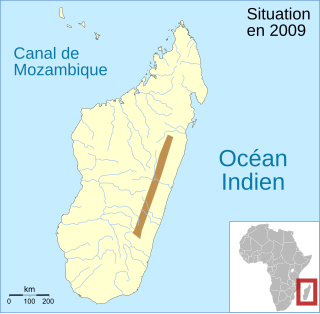
Rhombophryne coronata is a frog of the family Microhylidae. It is endemic to eastern Madagascar.
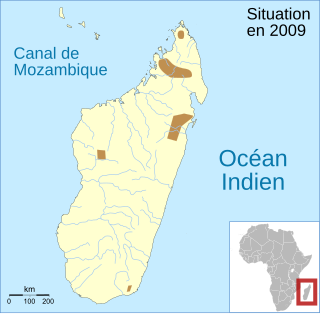
Rhombophryne laevipes is a frog of the family Microhylidae. It is endemic to Madagascar and known from localities in northern, eastern, southeastern, and mid-western parts of the island. It might be a species complex, with the "true" R. laevipes restricted to northern Madagascar.
Rhombophryne guentherpetersi is a frog of the family Microhylidae. It is endemic to northern Madagascar and known from the Tsaratanana Massif. It inhabits high-elevation forest and, perhaps, montane grassland, at elevations of 2,000–2,600 m (6,600–8,500 ft) above sea level. It is a rare species that suffers from habitat loss and degradation. It occurs in the Tsaratanana Reserve but the reserve borders are ambiguous, complicating management of the area.

Rhombophryne vaventy is a large species of frogs of the Madagascar endemic microhylid subfamily Cophylinae. It is one of the largest members of its genus.
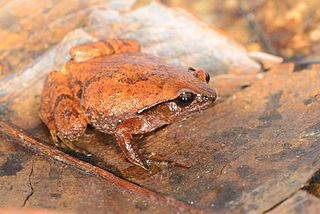
Rhombophryne botabota is a medium-sized species of frogs of the Madagascar endemic microhylid subfamily Cophylinae. It is found in the montane rainforests of northern Madagascar. It was described in 2016 from seven specimens.
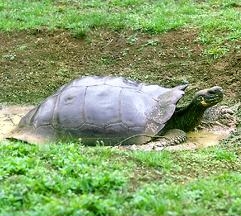
The Santiago Island giant tortoise, also known commonly as the Santiago giant tortoise and the James Island tortoise, is a subspecies of Galápagos tortoise in the family Testudinidae. The subspecies is endemic to Santiago Island in the Galápagos.














